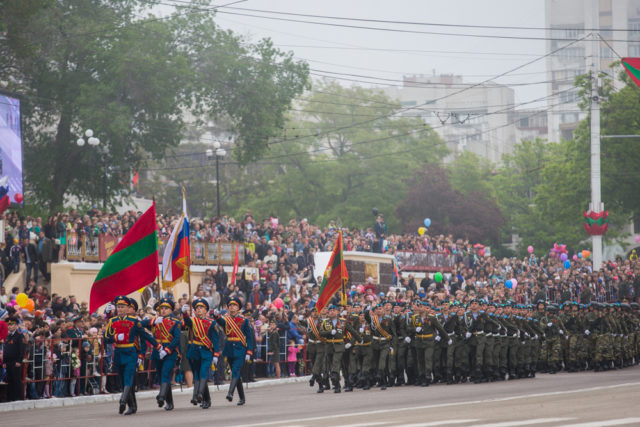
Russia Involving Transnistria in Ukrainian War, Raising Stakes for All Parties
Publication: Eurasia Daily Monitor Volume: 19 Issue: 52
By:

Transnistria, the breakaway Slavic-majority region in Moldova, usually attracts attention only when Moscow seeks to use to limit Moldovan moves toward unification with Romania or membership in European institutions. At times, analysts also point to it as an illustrative model for Russian expansion or Moscow’s designs on other breakaway regions across the former Soviet space (see EDM, August 12, 13, 2020). But now, President Vladimir Putin’s full-scale war in Ukraine is elevating Transnistria’s importance in at least four ways. The Russian-occupied region may be a new source of troops for Moscow’s invading forces. It is being considered as a potential base for a Russian attack on Odesa. The territory could see its future as a partially recognized statelet on the model of the Donetsk and Luhansk “peoples republics” (DPR, LPR) in Ukraine. Or the Kremlin may even see Transnistria as, ultimately, a component of a new Russian empire.
This plethora of actions and possibilities came into sharp relief on April 10. Namely, according to reports from Ukraine and the United Kingdom, Moscow has been recruiting soldiers in Transnistria to fight in Ukraine, a move understood to reflect the difficulty Russia has had in finding enough troops for that conflict (see EDM, March 31; KP v Ukraine, Twitter.com/DefenceHQ, The New Times, April 10). Moreover, Ukrainian military commanders announced they would shoot down any Russian planes that attempted to use Transnistria for attacks on Ukrainian targets, such as the nearby port city of Odesa (Glavred, April 8).
The Ukrainian fears did not appear unfounded. Rumors have been circulating about the possibility of Russian provocations against Ukraine from Transnistria, although both Transnistrian and Moldovan officials have tried to dismiss them (Omg.md, RIA Novosti, Regnum, April 11). The situation remains murky given the relatively poor control of the border between Ukraine and Moldova’s Transnistria combined with the fact that since the current phase of the Russo-Ukrainian war began on February 24, almost 29,000 Ukrainians have fled to that breakaway region. This has created a reservoir of people who might be sent back to Ukraine or used as a cover by others for a covert attack against Ukrainian targets (Novostipmr.com, April 11).
Meanwhile, three other developments have further muddied the waters, increasing the likelihood that Transnistria will play some (for now uncertain) role in the Russian assault on Ukraine or more broadly. First, officials in Transnistria demanded that the Moldovan government immediately enter into talks about a civilized “divorce” and that the international community recognize it as an independent state, lest events in Ukraine lead to provocations by Moldova or the use of Ukrainian forces against it (Politobzor.net, March 5). These demands and the claims they are supposedly based on, of course, could easily be yet another effort by Moscow to exploit Transnistria—this time not only against Moldova but against Ukraine as well. That second possibility appears quite plausible given that the pro-Moscow regime in Tiraspol has begun talking about the need to combat “Nazism” in Moldova, exactly the language the Kremlin has been using about Ukraine (RIA Novosti, April 12).
Second, Russia’s advance into Ukraine has had the effect of reducing the ability of shadowy figures in Transnistria to continue their black market East-West trade. One of the firms hit hardest, the Sherif corporation, appears to be seeking a way around this. Through its control of local media outlets and through its direct influence on Transnistrian politicians, the company is promoting a new approach that would open routes south through Moldova to replace those it had heretofore been using eastward into Ukraine. That effort looks to be behind new talks between officials from Transnistria with officials in Chisinau about a possible deal (RuBaltic, April 10). These moves, too, may be a feint, but they are further unsettling an already unstable situation.
And third, Russian commentators are outlining several possible futures for Transnistria—conspicuously employing more expansive language than they have used since the 1990s. One, for example, says that the breakaway republic may soon become part of Russia in a step-by-step manner, like the DPR and LPR (SMI.TODAY, April 8). As another possibility, RuBaltic portal writer Ilya Kiselyov suggests, Transnistria will assume a new and larger role given that he expects Russian forces soon to be on the border between what is now Ukraine and that republic. Once that happens, he suggests, “the further development of events for Transnistria could occur along several scenarios.” The presence of Russian forces on the border of Transnistria could allow Moscow to recognize that breakaway republic as independent, much as it has already done with the DNR and LNR. Or if Moscow wants to retain leverage in Moldova, it will then be in a position to demand that Chisinau give Transnistria broad autonomy with close ties to Russia as the price of Moscow’s not recognizing Transnistria’s independence. But in either case, this analyst contends, if a new “iron curtain” really does go up, Moscow is going to do what it can to make sure that this dividing line passes along the Dniestr River and not along the current borders between what is now Ukraine and Moldova (RuBaltic, April 10).
Kiselyov argues that Moscow must decide what to do soon because there is another option, one that may appear improbable but is “not impossible”: namely, Transnistria, in order to save its economy and to secure assistance from the United States and the European Union, might opt to “go West” along with Chisinau. That would have seriously negative consequences for Russia, and so, Kiselyov maintains, it must not be allowed. Transnistria is too useful a tool to be tossed aside; but how best to use it is still a matter of debate (RuBaltic, April 10).



